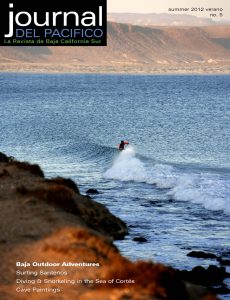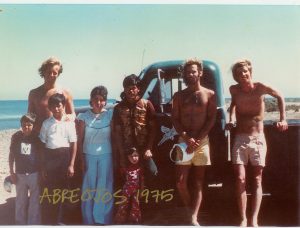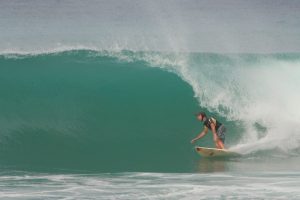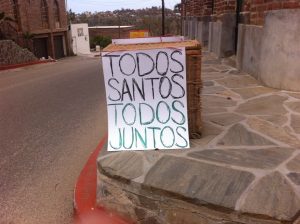
Forces of Nature: Hurricane Odile in Todos Santos and Pescadero
By Bryan Jáuregui, Todos Santos Eco Adventures.This article first appeared in Janice Kinne’s Journal del Pacifico.
When the fireman tossed the first baby to her at about 1:00 AM, Karina was dizzy with fear that she would drop the little girl. She didn’t. By the time the fireman tossed the third baby to her she was confident in her skill, had an assembly line set up with hand offs to Lorena and Julio, and had the whole situation managed so brilliantly that by 10:00 AM 150 people who had lost all or part of their homes in the fury of Hurricane Odile were safe, dry and having breakfast in the Casa del Estudiante del Todos Santos.
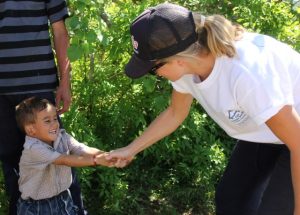
Jayna Schweitzer of the Palapa Society with her neighbors
Why on earth would a fireman toss a baby? Down the road in Pescadero Lalo and Pili were finding out. Pili is a pretty big guy, topping the scales at 250 pounds. Lalo is a little scrawnier, weighing in at 180. The 430 pounds of them were holding onto the inside beams of their roof with their hands, trying to keep it from blowing away. They succeeded for two hours before a particularly violent gust lifted the roof – with the two of them still attached – several feet off the ground. At that point they decided not to make the trip to Oz and let go. And that’s why the fireman had to toss the children: the wind was blowing so violently through the door that Karina could not propel herself forward the two meters to take them, and the fireman had to anchor himself at the entrance or risk not being able to get back out to help others. Category 3? Category 4? Doesn’t really matter. When it’s blowing hard enough to take your roof, your home and your child’s safety, it’s blowing hard enough.
Todos Santos, Todos Juntos
Before Hurricane Odile hit on September 14 and forever changed the storyline of Baja California, the communities of Todos Santos, Pescadero and other BCS towns were already coming together to fight a manmade force with the potential for devastation far beyond anything a single hurricane could unleash – an open pit gold mine in the Sierra de la Laguna mountains. The local and foreign communities had united at huge rallies and protests across the state, and even staged a multi-day vigil to prevent the mine from illegally drilling in connection with its planned desalination plant. A feeling of unity and empowerment permeated the air, and when that air was dramatically rent by Hurricane Odile, it only strengthened the feeling of community. No one was going to back down from a fight for home.
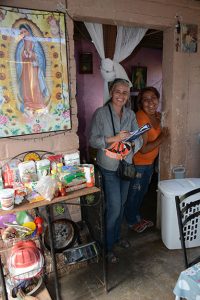
Serena Saltzman of the Palapa Society helping her neighbors
Karina, the administrator of the Casa del Estudiante del Todos Santos – or albergue as it is commonly known – was one of the first to witness that fighting spirit on a significant scale. She’d never met Marisol, the manager at Casa Tota in her life. But when she called her to ask for help, Marisol didn’t hesitate and delivered food for 150 people in just a few hours. The grocery stores Supermercado El Sol and Guluarte’s, the restaurants Landi’s and El Zaguan – all made sure that Karina and the rest of the albergue staff could feed the people in their care in those first few critical days, even as they were struggling with their own properties. Gabriela Guluarte sent along clothing for those who had lost everything, and Kappner from Tres Santos came with boxes of much needed personal items like shampoo, deodorant, underwear and baby food. Karina and Lorena spent 17 days working around the clock at the albergue, often with 150 sleeping under their roof and up to 200 mouths to feed at any given meal. Not only did no one miss a meal, but many others were sent home with “dispensas”, or care packages with several days worth of essential food items.
But the damage was extensive and the needs were great and a surfer named Justin Lindholm who spends his winters in Pescadaro was among the first to grasp that significant funds were going to be needed to advance the recovery. “Pescadero and its people are beautiful and have made a huge impact on my life. People say hi to you on the streets, really listen to you when you’re talking, and remember stories you might have told. They live day-to-day and worry little about the future. I admire that. Starting a fund for Pescadero was something I knew had to be done. I spent the fall and winter months of 2005 with the clean up effort after Hurricane Katrina in New Orleans. I saw what a hurricane is capable of and how helpless people are even in a powerful country like the US. I knew the people of Pescadero were going to need help to get back to normal.” Odile hit on September 14 and on September 15 Justin opened a GoFundMe account to raise money for hurricane relief in Pescadero. $6,000 was raised in the first few days alone, and people in desperate need of work were soon being paid fair wages to help clean the town and restore order.
In Todos Santos The Palapa Society – a nonprofit whose mission is to help educate the children of the town – had an  emergency meeting on September 20 to discuss what they could do to help the community. The meeting was over at 10:30 AM, and by noon they had set up a GoFundMe account to raise money for hurricane relief for Todos Santos. By 2:00 PM board members Oscar and Tori were with Karina at City Club in La Paz, where she was using the $1,000 advanced by Palapa to great effect. And by 9:00 AM on September 23 when the next meeting started, over $30,000 had already been raised. Before long people were getting new roofs, remote ranch families were receiving food, and people in need of work were getting it. Outside the venerable old Todos Santos Inn a hand written sign appeared, Todos Santos, Todos Juntos.
emergency meeting on September 20 to discuss what they could do to help the community. The meeting was over at 10:30 AM, and by noon they had set up a GoFundMe account to raise money for hurricane relief for Todos Santos. By 2:00 PM board members Oscar and Tori were with Karina at City Club in La Paz, where she was using the $1,000 advanced by Palapa to great effect. And by 9:00 AM on September 23 when the next meeting started, over $30,000 had already been raised. Before long people were getting new roofs, remote ranch families were receiving food, and people in need of work were getting it. Outside the venerable old Todos Santos Inn a hand written sign appeared, Todos Santos, Todos Juntos.
Viva México!
The sight of Mexican troops crossing the US border to help Americans in the aftermath of Hurricane Katrina discombobulated many US citizens (“poor” Mexicans helping “rich” Americans?), but disaster relief is actually a core competency of the Mexican military. Todos Santos woke up to Odile’s handiwork on Monday, on Tuesday Army and Navy troops were in the neighborhoods handing out emergency food and water, and on Wednesday they were also handing out sleeping pads, clearing debris from the streets and parks, and helping to ensure that the looters from Cabo didn’t make their way into town.
But in a democracy, military action is just an expression of political will, and on Thursday a helicopter carrying Mexican president Enrique Peña Nieto flew over town. Skeptical gringos likened this to W’s infamous flyover of New Orleans after Katrina and rolled their eyes. But this helicopter landed, Peña Nieto got out, and he went and met with Karina and Lorena at the albergue. He toured the town, he made a speech, he made promises and he left. By Friday morning the military was helping with the cooking chores at the albergue, and on Saturday 120 workers and dozens of trucks from CFE – the Comisión Federal de Electricidad – arrived to begin restoring electricity to town. Not only did they work around the clock to get the town running again, they stayed in hotels and B&Bs across town and paid for the service. Todos Santos is a town fuelled largely by tourism, and it is hard to know if people were more grateful for the restored electricity, or for the income provided at a time when repair costs were soaring, employee needs were escalating, and cash flow was crashing in the wave of cancellations that wiped out reservations for September, October and even some of November. The town swelled with gratitude for CFE, and the skim boarders started returning to Playa La Poza to enjoy the late summer afternoons.
God Bless Rock ‘N Roll
One of the reasons that it’s not the end of the world as we know it is that Peter Buck loves Todos Santos. The lead guitarist of REM bought a house in town, and started the Todos Santos Music Festival in 2012 to raise money for the Palapa Society; he believes in and wants to further its mission of serving the educational and health needs of the children of Todos Santos. So when Odile struck, Peter and the music festival immediately fronted the Palapa Society $10,000 from ticket sales for the 2015 event to help with the rebuilding efforts in town. Said Peter, “We will donate all of the profits from the 2015 festival to help people in Todos Santos reconstruct their lives, homes and businesses.We also hope that the festival’s return in January will serve as a symbol of Todos Santos’ resilience and ability to bounce back from this terrible tragedy.”
Peter Buck and his friends have shown Baja that insanely talented and successful rock stars can also set the gold standard for generosity, so perhaps the area was not that surprised to learn that one of Mexico’s most-loved rock bands, Maná, was also pitching in to help in the aftermath of Odile. Maná’s nonprofit, Fundación Ecologica Selva Negra, working with the large Mexican corporation Verde Valle and the regional director of WildCoast, arrived at the port of La Paz on October 5 with 15 tons of rice, lentils, beans and other food basics. In Todos Santos 20 families in one of the hardest hit areas, Nuevo San Juan, directly received food from Selva Negra. They made sure that 50 families in their neighborhood benefitted from the bounty. Out at Cerritos, live music started flowing again.
The Beatles Got it Right
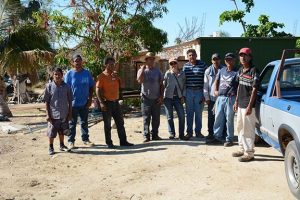
Oscar, Benny and their crew at a neighbor’s house working on the roof
When the communities of Todos Santos and Pescadero asked for help, the world answered. Americans, Canadians, Europeans. People for whom these communities are seemingly just vacation destinations reached deep, found their inner rock stars, and gave. They made their friends give. They held fundraisers in their communities and they showered social media with notes of support. As of this writing the fund for Justin’s hurricane relief effort for Pescadero stands at about $15,000, and the fund for the Palapa Society’s hurricane relief effort for Todos Santos is over $80,000. And they’re getting things done.
In Pescadero, Alec, April, Bridget and Hesed held a community meeting at Baja Beans, and 150 people showed up to see how they could help their neighbors. Sam, Ronnie, Epi, Mario and Ana Maria formed cleanup teams with the local teenagers, who have been competing to see who can clear the most debris. In Todos Santos, the Palapa Society hired two contractors, Oscar and Bennie, who are coordinating the work of 3 teams to put new roofs on homes. Over 150 houses have received new roofs so far, and the work is not slowing down. They’ve created two designs for simple wooden homes for the families who lost everything, and hope to have those under construction soon.
These stories are just the tip of the iceberg, and scarcely begin to convey the enormity of the effort underway to restore the shelter, food, work and normal life ripped away by Odile. It is impossible to relate the countless acts of kindness, generosity, selflessness, humor and grace that saw our communities through the immediate aftermath of the storm, and continue to rebuild it all these weeks later. Robert Hall, the town dharma dude and defacto non-religious spiritual leader, says that The Beatles had it right all along. “All you need is love. Odile was so powerful that it was able to tear the fabric of our lives, but the healing is love. Love is what makes it possible when we barely have the saliva to swallow these big bites of reality. Love is all you need.” Just off shore, the humpbacks returned for the winter, singing their sweet Baja serenades.
We’re Not Distracted
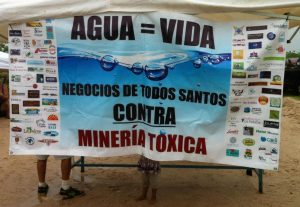
Water = Life. Businesses of Todos Santos Against Toxic Mining
It was about 2:00 AM when the French doors in Wendy’s bedroom started banging so violently that she had to throw her body weight against them to try and keep the storm out of her house. As the doors heaved and she pushed, a side length of her nightgown swept between the two doors, which then promptly slammed shut. She was pinned against the frame, completely unable to move. At first she was gripped by panic, but then she started to laugh. Because really, a tiny woman fighting a huge storm being trapped by her nightie is kind of funny. And while she waited for the rhythm of the storm to shift so she could retrieve the trapped material, she thought about all the wonderful water the storm was bringing, and how it needed to be protected from the lethal chemicals connected to the gold mine. She thought about the next steps the citizens of Baja California plan to take to protect our water and our lives. Because really, a tiny woman fighting a huge corporation as part of a determined community is pretty serious indeed. It’s a force of nature. Love is all you need.
Jamie Sechrist, Tori Sepulveda, Serena Saltzman, Erick Ochoa, Alec and April Tidey, Ana Maria Peters, Sam Sitkin, Ronnie Barkas, Ivo Mondragen all contributed to this story.
Get involved!
If you would like to contribute to the continued reconstruction of homes and lives in Todos Santos and Pescadero please donate to the following funds (and don’t be shy about getting your friends to contribute too!):
- Pescadero Hurricane Relief, started by Justin Lindholm: www.gofundme.com/ej76xg
- Todos Santos Hurricane Relief, started by The Palapa Society of Todos Santos, AC: www.gofundme.com/eskrns
- To learn about and contribute to the fight against open pit gold mining in Baja California Sur please visit: defiendelasierra.org
- To receive more of Dr. Robert K. Hall’s remarkable wisdom on Hurricane Odile please visit: roberthalldharmatalks.wordpress.com/2014/10/01/baja-hurricane-dharma

